|
MODULE 3 - SECTION 3 - THE SECOND ORDER NEURONS of the DCML
|
1
 |
|
Fibers of this pathway are organized in a somatotopic manner (fibers from adjacent parts of the body's surface run in adjacent parts of the pathway), and the color code used to represent this is:
Sacral - green
Lumbar - purple
Low Thoracic - red
High Thoracic - light blue
Cervical - dark blue |
| The first order neurons of this pathway are large myelinated axons which enter in the medial part of the dorsal root. The region where each dorsal root enters the spinal cord is often called the "dorsal root entry zone" and these fibers enter in the medial part of the zone. The fibers then bifurcate, with one branch passing deeply to terminate in the dorsal horn and the other branch passing medially to ascend in the posterior funiculus. |
|
2
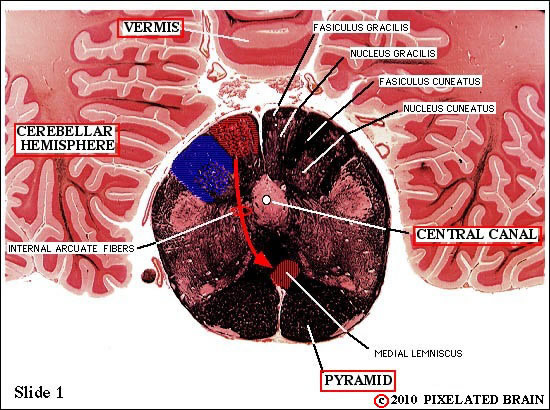 |
 |
LINKS
Atlas |
This slide passes through the caudal medulla. Second order neurons, within the nucleus gracilis give rise to fibers which decussate and begin to pile up ventrally as the first component of the medial lemniscus.
We will remind you repeatedly of the great clinical importance of knowing the level at which motor and sensory pathways cross the midline. For the DC-ML pathway the decussation occurs here, at the level of the caudal medulla. |
|
3
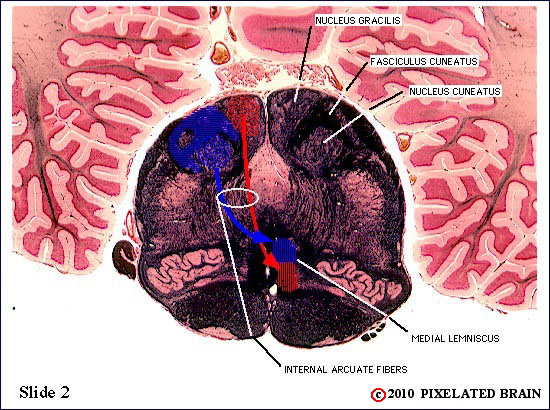 |
 |
LINKS |
| |
|
4
 |
 |
|
Formation of the medial lemniscus is now almost complete. It seems to be squeezed into a vertical band as it tries to get by the two inferior olives. Note that the central canal of the spinal cord is now opening up to form the fourth ventricle, roofed by choroid plexus.
Recognize that at this level, sensory information from the lower part of the body (red) travels in the ventral part of the medial lemniscus, and information from the upper part of the body travels in the more dorsal (blue) part of the structure. |
|
5
 |
 |
|
| Formation of the medial lemniscus is complete. |
|
6
 |
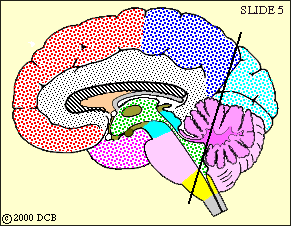 |
|
| Little change here. This is a classical section through the mid-medulla. |
|
7
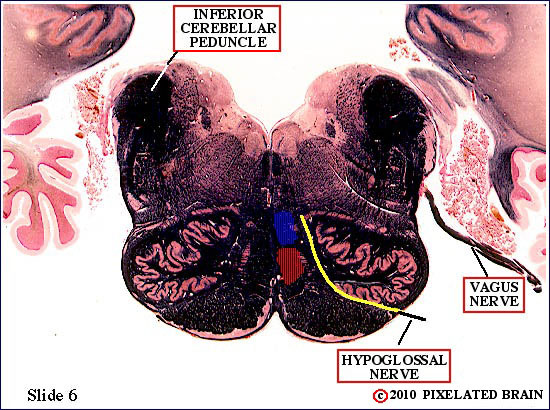 |
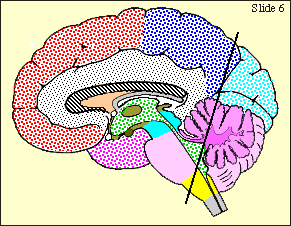 |
|
| Still the mid-medulla, and little change. Note the openings, laterally, which allow CSF to escape from the fourth ventricle into the subarachnoid space. Note that an exiting cranial nerve passes right by the medial lemniscus; why might that relationship be important? |
|
8
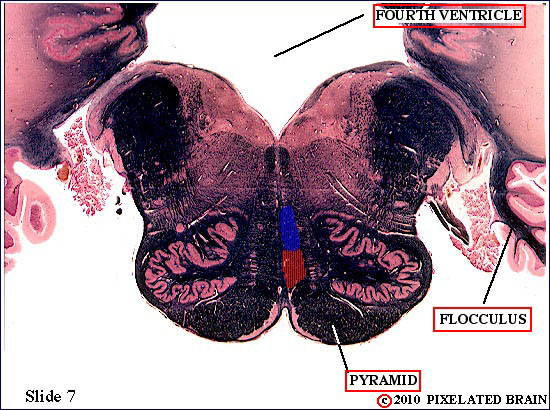 |
 |
|
| |
|
9
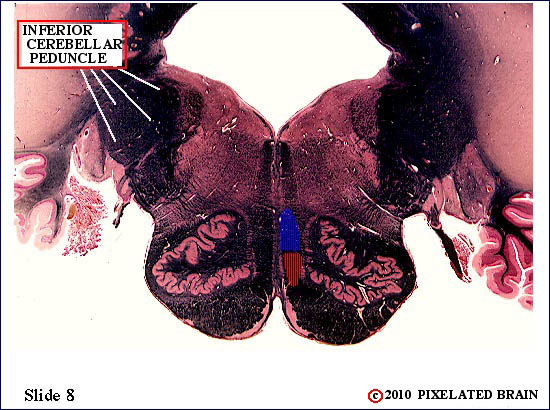 |
 |
|
| Little change. The medial lemniscus is still "pressed against the midline" and held in a vertical position by the inferior olive. |
|
10
| |
|
|
| |
|
11
| |
|
|
| |
|
12
| |
|
|
| |
|
13
| |
|
|
| |
|
14
| |
|
|
| |
|
15
| |
|
|
| |
|
16
| |
|
|
| |
|
17
| |
|
|
| |
|
18
| |
|
|
| |
|
19
| |
|
|
| |
|
20
| |
|
|
| |
|
21
| |
|
|
| |
|
22
| |
|
|
| |
|
23
| |
|
|
| |
|
24
| |
|
|
| |
|
1
| |
|
|
| |
|
2
| |
|
|
| |
|
3
| |
|
|
| |
|
4
| |
|
|
| |
|
5
| |
|
|
| |
|
6
| |
|
|
| |
|
7
| |
|
|
| |
|
8
| |
|
|
| |
|
9
| |
|
|
| |
|
10
| |
|
|
| |
|
11
| |
|
|
| |
|
12
| |
|
|
| |
|
13
| |
|
|
| |
|
14
| |
|
|
| |
|
15
| |
|
|
| |
|
16
| |
|
|
| |
|
17
| |
|
|
| |
|
18
| |
|
|
| |
|
19
| |
|
|
| |
|
20
| |
|
|
| |
|
21
| |
|
|
| |
|
22
| |
|
|
| |
|
23
| |
|
|
| |
|
24
| |
|
|
| |
|
xxx
|
SITE MAP MOD 3 HOME PIXBRAIN HOME I WANT TO COMMENT
NEXT
|
 |
 |
 |
















